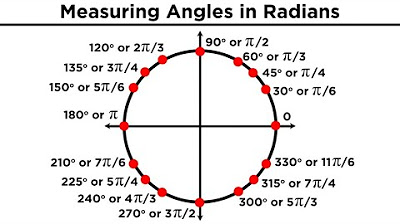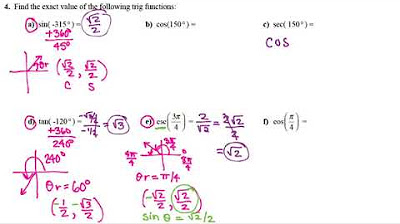Coterminal Angles In Radians & Degrees - Basic Introduction, Trigonometry
TLDRThe video script explains coterminal angles as angles that share the same terminal side but have different measures. It illustrates this concept with examples, such as 30 degrees and 390 degrees, which are coterminal because they point to the same position on a circle. The script teaches viewers how to find coterminal angles by adding or subtracting multiples of 360 degrees for degrees or 2π for radians. It demonstrates this process with various examples, including positive and negative angles, and converting between degrees and radians, to find angles within specific ranges, such as between 0 and 360 degrees or 0 and 2π.
Takeaways
- 📐 Coterminal angles are angles that point to the same terminal side but have different measures.
- 🔄 Coterminal angles can be found by adding or subtracting multiples of 360 degrees for angles measured in degrees, or multiples of 2π for angles measured in radians.
- 👉 For example, 30 degrees and 390 degrees are coterminal because they point to the same terminal side.
- ➕ To find a coterminal angle within a specific range, such as between 0 and 360 degrees, subtract multiples of 360 from the given angle until it falls within the desired range.
- ➖ Similarly, to adjust a negative angle into the range of 0 to 360 degrees, add multiples of 360 until it is positive and within the range.
- 🔢 The script provides an example where 430 degrees is adjusted to a coterminal angle of 70 degrees by subtracting 360 degrees.
- ➡️ Another example shows that a negative angle, such as -150 degrees, can be adjusted to a positive coterminal angle of 210 degrees by adding 360 degrees.
- 🔄 The process of finding coterminal angles is demonstrated with both positive and negative angles, as well as angles greater than 360 degrees.
- 📚 The script also explains how to find coterminal angles in radians, using the same principle of adding or subtracting multiples of 2π.
- 📈 An example with radians is given where thirteen pi over six is reduced to pi over six (equivalent to 30 degrees) by subtracting two pi (or 12 pi over six).
- 🔢 The final examples in the script involve adjusting negative angles in radians to positive coterminal angles within the range of 0 to 2π.
Q & A
What are coterminal angles?
-Coterminal angles are angles that share the same terminal side but have different magnitudes. They differ by full rotations, or multiples of 360 degrees.
How do you identify if two angles are coterminal?
-Two angles are coterminal if they have the same terminal side. They can be identified by checking if their difference is an integer multiple of 360 degrees.
Can you give an example of coterminal angles?
-An example of coterminal angles is 30 degrees and 390 degrees. They both point to the same terminal ray but have different magnitudes.
What happens when you add 360 degrees to an angle?
-Adding 360 degrees to an angle results in a coterminal angle that has the same terminal side but a different magnitude. It essentially represents the same angle but after one full rotation.
How do you find a coterminal angle within a specific range?
-To find a coterminal angle within a specific range, such as between 0 and 360 degrees, you can subtract or add multiples of 360 degrees to the given angle until it falls within the desired range.
What is the relationship between degrees and radians when finding coterminal angles?
-In radians, the equivalent of 360 degrees is 2π. So, to find coterminal angles in radians, you add or subtract multiples of 2π from the given angle.
Can negative angles be coterminal with positive angles?
-Yes, negative angles can be coterminal with positive angles. For example, 150 degrees and -210 degrees are coterminal because they end up at the same position on the unit circle after traveling in opposite directions.
How do you find a positive coterminal angle for a given angle greater than 360 degrees?
-To find a positive coterminal angle for an angle greater than 360 degrees, subtract multiples of 360 degrees from the given angle until the result is less than 360 degrees.
What is the process for finding a coterminal angle for a negative angle less than 0 degrees?
-For a negative angle less than 0 degrees, add multiples of 360 degrees to the angle until the result is positive and within the desired range, such as between 0 and 360 degrees.
Can you provide a step-by-step method for finding coterminal angles in radians?
-To find coterminal angles in radians, first determine if the given angle is greater than or less than 2π. If it's greater, subtract multiples of 2π until it's less than 2π. If it's less, add multiples of 2π until it's positive and within the desired range.
Outlines
📐 Understanding Coterminal Angles
Coterminal angles are angles that share the same terminal side on a circle despite having different numerical values. The script explains that these angles can be identified by their difference being a multiple of 360 degrees. For instance, 30 degrees and 390 degrees are coterminal because they point to the same direction. The concept is further clarified with examples involving both positive and negative angles, such as 150 degrees and -210 degrees. The process to find a coterminal angle involves adding or subtracting 360 degrees for angles in degrees or 2π for angles in radians. Practical examples demonstrate how to adjust given angles to find coterminal angles within a specific range, like between 0 and 360 degrees or 0 and 2π.
🔍 Calculating Coterminal Angles in Radians
This paragraph delves into the specifics of finding coterminal angles when the given angle is measured in radians. It uses the example of an angle of thirteen pi over six, which exceeds the two pi (or 360 degrees) limit. The explanation involves subtracting multiples of two pi from the given angle to find an equivalent angle within the desired range. The process is illustrated with step-by-step calculations, showing how to adjust the angle to fall between zero and two pi. The paragraph also addresses how to handle negative angles, such as negative eleven pi over four, by adding two pi until the result is positive and within the acceptable range. The key takeaway is the methodical approach to adjusting angles by adding or subtracting 360 degrees or 2π to find coterminal angles.
Mindmap
Keywords
💡Coterminal Angles
💡Terminal Ray
💡Degrees
💡Radians
💡Full Rotation
💡Add/Subtract 360/2π
💡Range
💡Negative Angles
💡Common Denominators
💡Multiplication by Four Over Four
💡Positive Coterminal Angle
Highlights
Coterminal angles are angles that land on the same position but have different measures.
For example, 30 degrees and 390 degrees are coterminal because they point to the same terminal ray.
Coterminal angles differ by a full rotation of 360 degrees.
Adding 30 degrees with 360 degrees gives the coterminal angle 390 degrees.
150 degrees and negative 210 degrees are coterminal angles that can be found by subtracting 150 by 360.
To find a coterminal angle, add or subtract 360 degrees.
In radians, coterminal angles can be found by adding or subtracting 2π.
A positive coterminal angle between 0 and 360 degrees for 430 degrees can be found by subtracting 430 by 360.
For a negative angle like -150 degrees, add 360 to find the coterminal angle 210 degrees.
To find a coterminal angle for 800 degrees, subtract 360 twice to get 80 degrees.
For a negative angle like -500 degrees, add 360 twice to get the coterminal angle 220 degrees.
For angles in radians, subtract by 2π to bring it between 0 and 2π.
The coterminal angle for thirteen pi over six is found by subtracting two pi, resulting in pi over six.
For a negative angle in radians, such as negative 11 pi over four, add two pi to find the coterminal angle.
The coterminal angle for negative 11 pi over four is five pi over four after adding two pi twice.
Transcripts
Browse More Related Video
5.0 / 5 (0 votes)
Thanks for rating:





